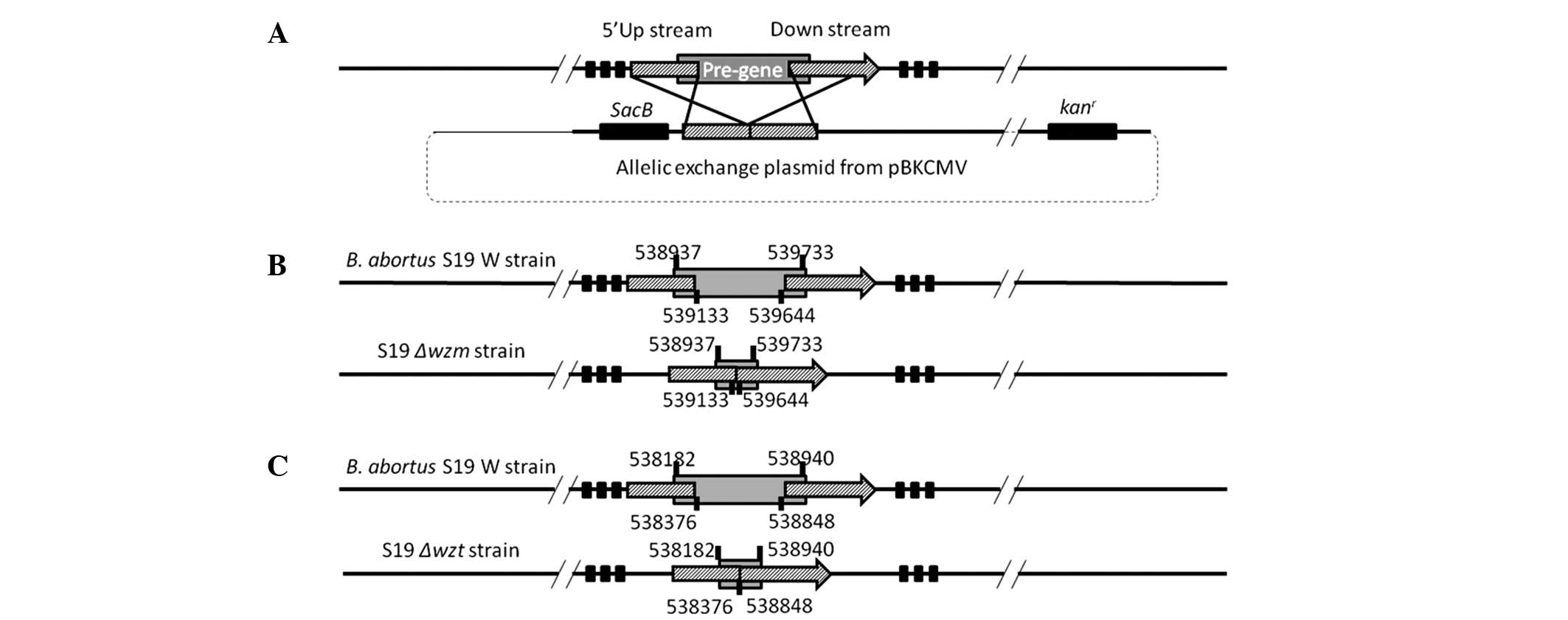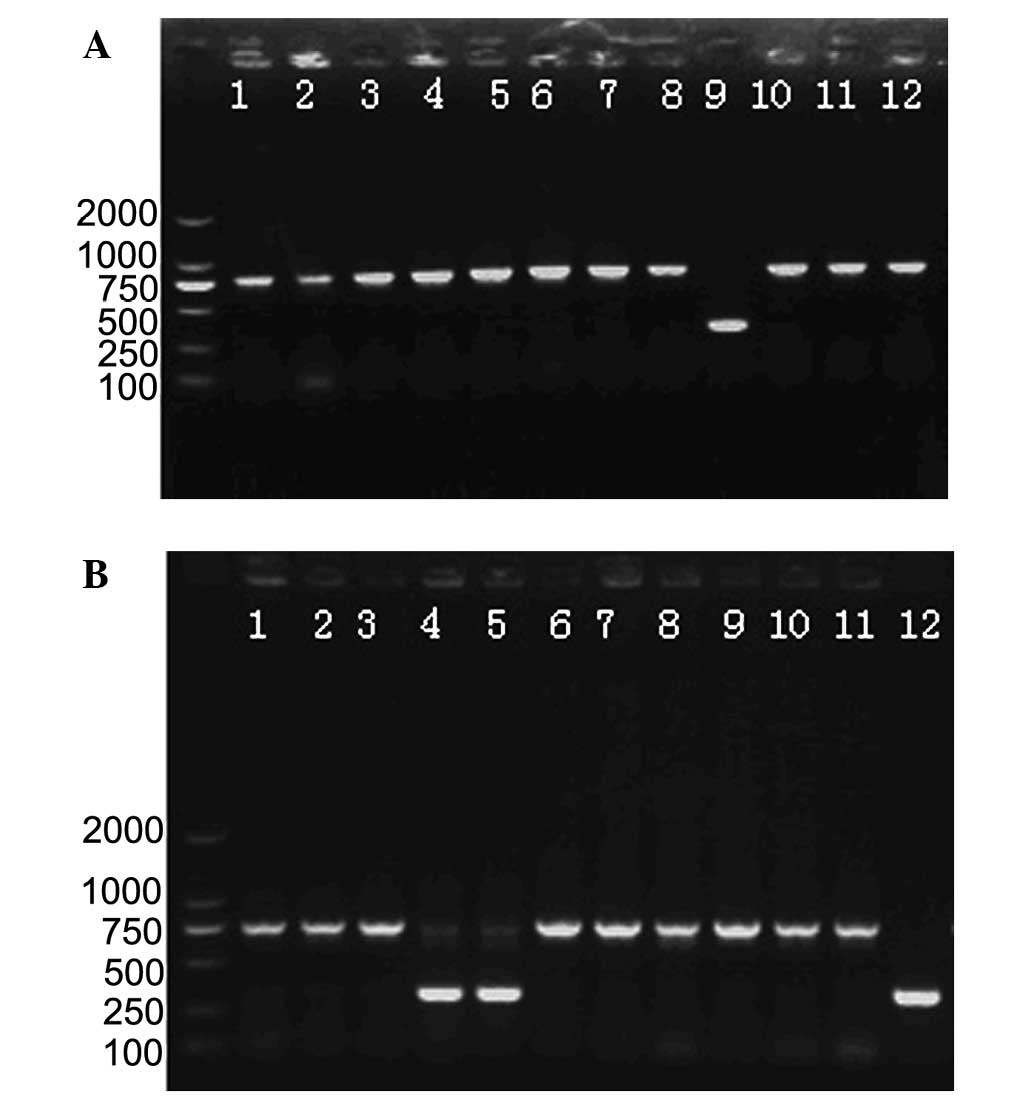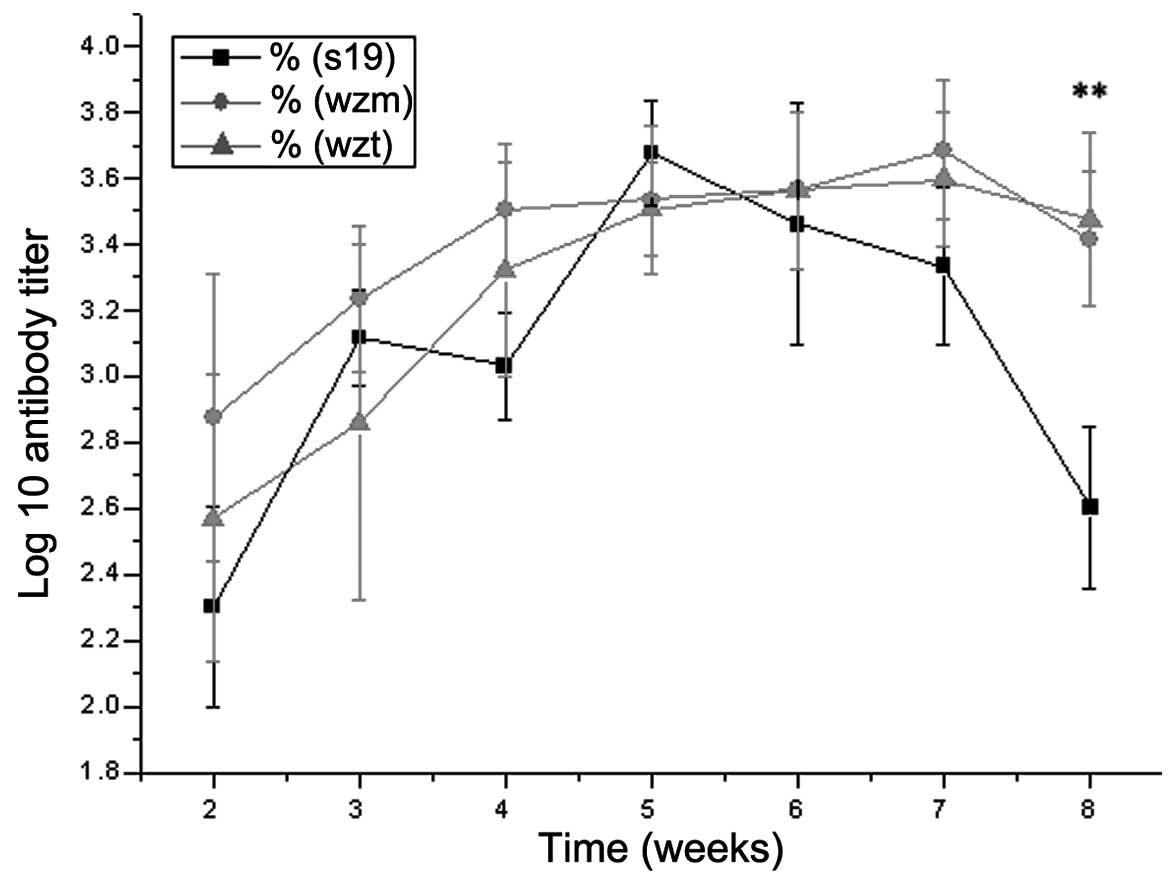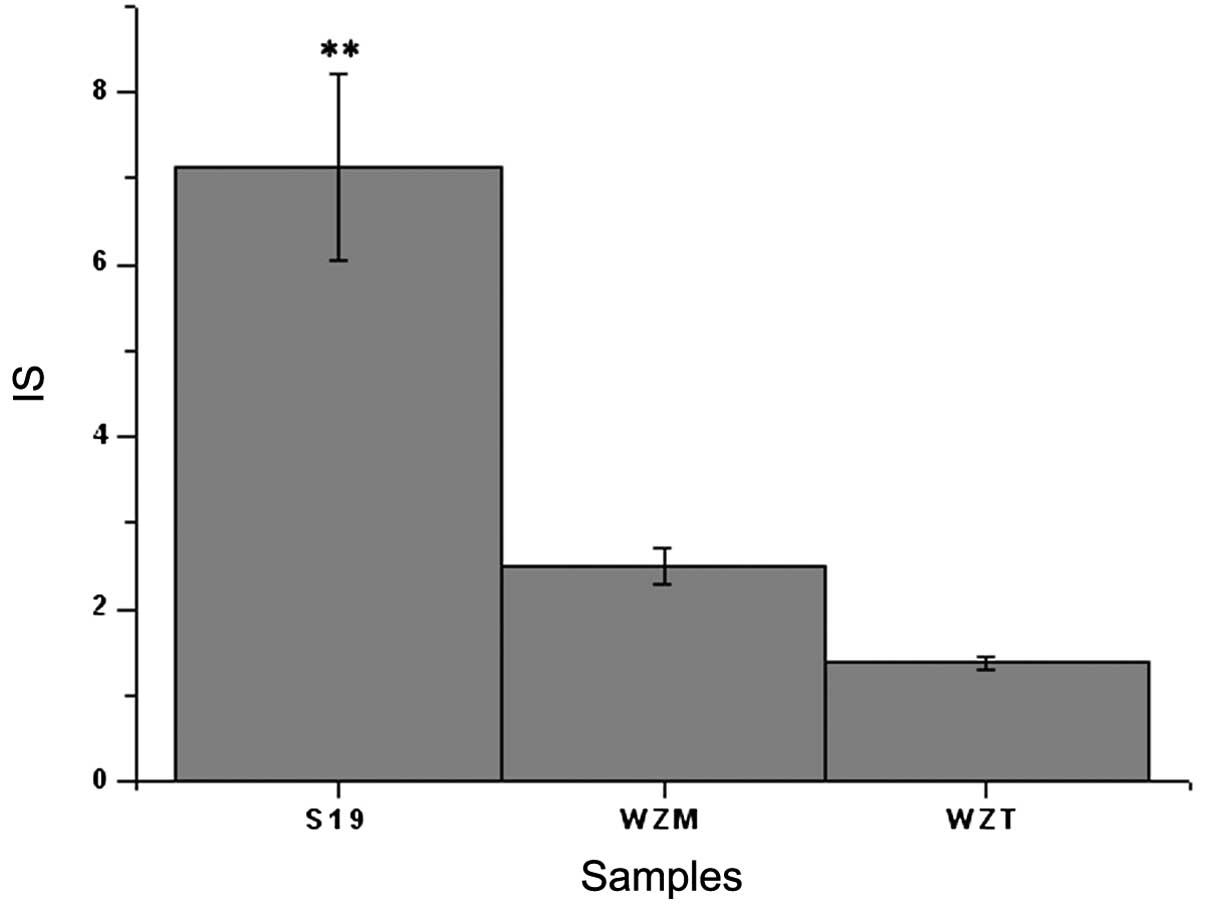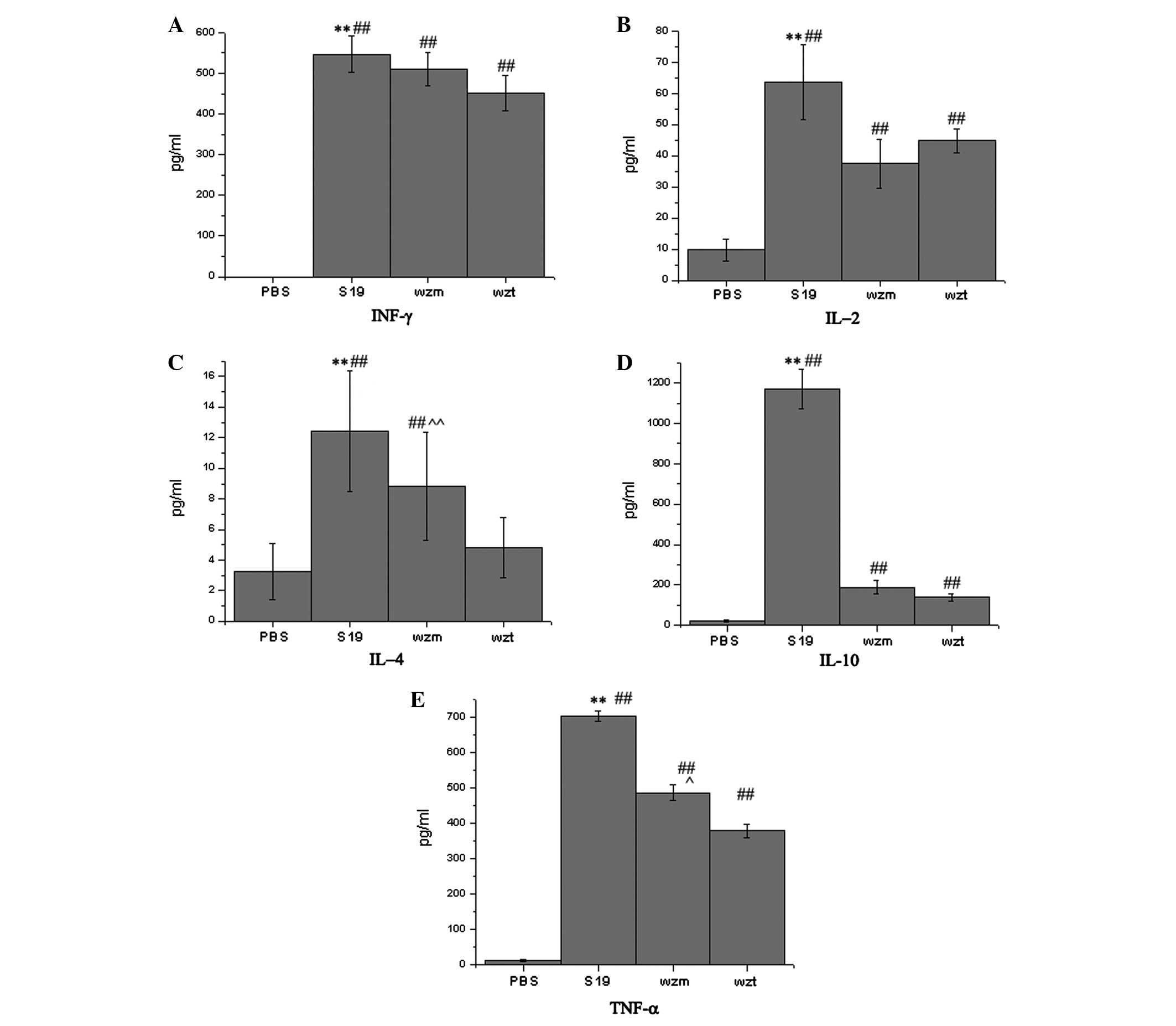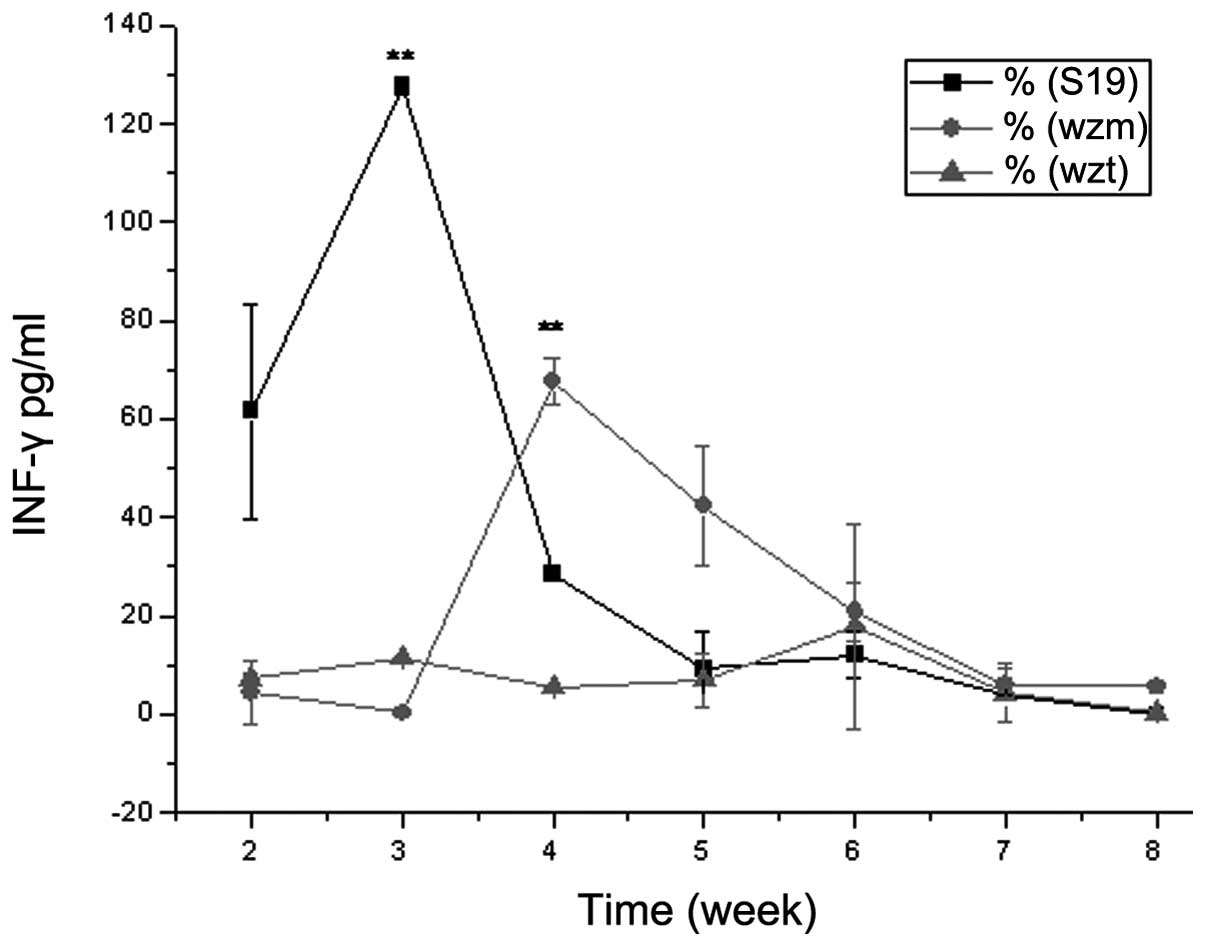Immunogenic response induced by wzm and wzt gene deletion mutants from Brucella abortus S19
- Authors:
- Published online on: November 18, 2013 https://doi.org/10.3892/mmr.2013.1810
- Pages: 653-658
Abstract
Introduction
Brucella species, the cause of brucellosis in humans and animals, are facultative intracellular bacteria. Brucella invades phagocytic and non-phagocytic cells and survives inside the host cells (1,2). The properties of the intracellular lifestyle of Brucella limit the number of antibiotics that are effective against these organisms once they form Brucella-containing vacuoles (BCVs) (3). Under most conditions, control of brucellosis in animal reservoirs is achieved via vaccination. Human brucellosis has also been controlled by immunization and culling within cattle, goat and sheep herds (4,5).
Currently there are no vaccines for humans and the useful vaccines for livestock are (Brucella abortus) B. abortus S19 and RB51 for cattle and Brucella melitensis (B. melitensis) Rev1 for small ruminants (6,7). B. abortus S19 has been widely used to prevent cattle brucellosis, as it usually has low virulence. However, it is infectious in humans and always causes abortion when used in pregnant animals (8,9). Since B. abortus S19 induces antibodies to the O-polysaccharide, it is difficult to distinguish from wild-type infection. The relevant diagnostic antigen is the smooth lipopolysaccharide (LPS) present in field strains, as well as in B. abortus S19 and B. melitensis Rev 1 (10–12). The development of a safe and efficacious vaccine that conquers this serological obstacle may have a broad impact on public health.
LPS provides bacterial resistance to antimicrobial attacks and modulates the host immune response, which makes it an important virulence factor for survival and replication in the host cell (1,13). It provides Brucella with resistance to innate immunity antibacterial responses by inhibiting complement and antibacterial peptide attacks, and by preventing the synthesis of immune mediators (14–16). The O-chain appears to help Brucella to invade cells in the early entry stage (17).
Brucellae without O-side chains are termed as rough or ‘R’ strain. R Brucella species or mutants lack the antigenic O-side chain and they do not induce anti-O-side chain antibodies. Currently, vaccinated hosts are difficult to distinguish from wild-type-infected hosts by common serological tests. It has been shown that Brucella R mutants are attenuated; therefore, R mutants have potential for use as vaccines (18–22). Several genes of B. melitensis 16M LPS synthesis were analyzed and ABC-type transporter (integral membrane protein, Wzm) and ABC-type transporter (ATPase domain, Wzt) were determined to be putative components of the ABC transporter system. The wzm/wzt mutant was proven to lead to the absence of the O-side-chain on the bacterial surface (23,24).
The wzt mutant of B. melitensis 16M was evaluated and determined to have virulence-reducing potential in a mouse model (25). In recent years, LPS has been shown to interfere with major histocompatibility complex (MHC)-II presentation, which inhibits peptide presentation in cells (13,16). In the present study, we constructed wzm and wzt gene partial deletion mutants with no DNA marker addition, in order to estimate the survival in vivo and the serological response. This may provide us with an improved understanding of the effect of wzm and wzt genes on the induction of immunity caused by the S19 vaccine strain.
Materials and methods
Bacterial strains and growth conditions
Escherichia coli DH5α strain was grown on Luria-Bertani broth (LB) agar at 37°C. Brucella strains B. abortus S19, Δwzm and Δwzt were grown on tryptic soy broth (TSB, Sigma, St. Louis, MO, USA) agar at 37°C. Ampicillin (100 μg/ml) and kanamycin (50 μg/ml) were added for plasmid screening if required. TSB medium (7% sucrose) was prepared for screening of allelic-exchange mutants.
Construction of wzt and wzm mutants
The allelic exchange plasmids were constructed by pBKCMV (kanr) with a sacB gene and fragments upstream and downstream of target genes. The sacB gene along with its promoter was amplified from pIBP279 (provided by Nanjing Agricultural University) using PCR methods and ligated into pBKsacB to construct pBKsacBwzm and pBKsacBwzt (Table I). Competent cells of B. abortus S19 were prepared and the constructed plasmid was electroporated into the cells at 1,500 kV [1-mm gap cuvette; BTX, Harvard Apparatus, Inc, Holliston, MA, USA]. Subsequently, 1 ml SOC (2% tryptone, 0.5% yeast extract, 10 mM NaCl, 2.5 mM KCl, 10 mM CaCl2, 10 mM MgSO4 and 20 mM glucose) was added and cells were grown under agitation at 28°C for 24 h and then plated on TSB agar (kanr) and cultured for 96 h at 28°C. The mutants were confirmed using PCR. The phenotype of the mutants was then determined by agglutination with acriflavine at a dilution of 1:100 (26).
Animals
The 4–6-week-old female specific pathogen-free (SPF) BALB/c mice were provided by the animal centre of Jilin University (Changchun, China). Mice were bred in the animal facilities with filtered air in a restricted-access room and under pathogen-limited conditions. Mice were acclimatised for a minimum of one week prior to the experiment and water and food was provided ad libitum. The animal experiments were approved by the Center of Laboratory Animals, Jilin University, China.
Serological test and antibody dynamics
Female BALB/c mice of 6–8 weeks of age were housed with water and food. Animals were randomly allocated to groups and acclimatised for 1 week prior to the initiation of experiments (n=5). To prepare the inoculated samples, bacteria were suspended in PBS and adjusted to the appropriate 108 CFU/ml in the same buffer. Blood samples from BALB/c mice were collected and allowed to clot for 12 h at 4°C and centrifuged. Serum was divided into Eppendorf tubes (Eppendorf, Hamburg, Germany), and stored at −80°C. The Rose Bengal plate agglutination test (RBPT, Harbin Pharmaceutical Group Bio-vaccine Co., Harbin, China) was carried out by mixing 30 μl serum and 30 μl antigen, and the reaction was observed after 4 min.
The IgG antibody titer was estimated by indirect enzyme-linked immunosorbent assay (ELISA). The 96-well plates were coated by diluted Brucella antigens S19, Δwzm and Δwzt (pH 9.6, 0.05 M carbonate buffer 100 μl each well, antigen concentration 108 pfu), at 4°C overnight. The plate was washed with 200 μl PBST buffer (pH 7.4, 0.01 M PBS: Tween-20, 1:1,000) three times, for 3 min each time, and then blocked by 100 μl 1% BSA (pH 7.4) and incubated at 37°C for 1 h followed by three washes with PBST. The sera samples diluted from 1:100 to 1:3,200 were added and incubated at 37°C for 1 h. After three washes with PBST, enzyme-labeled goat anti-mouse IgG (1:5,000) was added and incubated at 37°C for 1 h and then washed with PBST three times. TMB substrate solution (100 μl) was then added and incubated at 37°C for 10 min (in light). Then, 50 μl 2 M sulfate buffer was added to stop the reaction, followed by detection of optical density (OD) at 490 nm. The antibody titer was described as the diluted ratio controlled by the S/N ratio. If the S/N ratio was ≥2.1, the sample of serum was considered positive. The S/N ratio was calculated as: (sample - blank)OD490/(negative - blank)OD490.
Lymphocyte proliferation
After injecting antigens for 4 weeks, the spleens of mice were removed under sterile conditions, put in a sterile Petri dish with 4 ml lymphocyte separation liquid (Dakewe Biotech Co., Shenzhen, China) and then ground with a disposable syringe core in a 200-mesh nylon sieve (74 μm pore diameter). The spleen cell suspension was then added to a sterile centrifuge tube and 500 μl of RPMI-1640 medium was gradually added. The cells were then centrifuged for 10 min at 300 × g. The lymphocyte layer was placed into new centrifuge tubes, resuspended in 10 ml of RPMI-1640 and centrifuged for 2 min at 1,500 rpm. Subsequently, 5 ml of 0.15 M Tris-NH4Cl solution was added to the cells and the cells were centrifuged at 200 × g for 5 min after 5 min incubation at room temperature. The supernatant was removed and the cells were washed twice with RPMI-1640. The lymphocytes were resuspended by RPMI-1640 with 5% FBS and the cell concentration was adjusted to 2×106/ml.
The lymphocytes (1×104 per well in triplicate) were incubated with corresponding antigens (multiplicity of infection of 200 CFU/cell; PBS in RPMI-1640 medium as negative control) in 96-well plates at 37°C in an atmosphere containing 5% (v/v) CO2. After 24 h of culture, 20 μl MTS solution was added to each well and the cells were incubated for 4 h at 37°C in an atmosphere containing 5% (v/v) CO2. The absorbance (optical density, OD) at 490 nm was recorded. Lymphocyte proliferation ratio (IS) was calculated as: (OD-OD1640)/(ODPBS-OD1640).
Cytokine induction in vitro and in vivo
The lymphocyte cells (1×105 per well in triplicate) were incubated with corresponding antigens (multiplicity of infection of 200 CFU/cell; PBS in RPMI-1640 as negative control) for 24 h in 24-well plates at 37°C in an atmosphere containing 5% (v/v) CO2. The cell culture supernatants were collected and stored at −80°C. The cytokine levels were analyzed using R&D Quantikine TNF-α, INF-γ, IL-2, IL-4 and IL-10 kits according to the manufacturer's instructions (Minneapolis, MN, USA). The INF-γ levels of serum were estimated using the same method.
Statistical analysis
The data were analyzed using Original 7.5 software and presented as the means ± standard deviation (mean ± SD). Significant differences between the groups were identified by one-way ANOVA (significant difference, P<0.01 and P<0.05).
Results
Screening of mutant strains
In order to obtain partial mutants of wzm and wzt genes, the plasmids pBKsacBwzm and pBKsacBwzt were constructed as shown in Fig. 1A–C. The plasmid was then electroporated into B. abortus S19 cells. The transformed samples were plated on TSB agar medium (Kanr) for the first screen. The colonies were added to TSB medium and detected by PCR with sacB primers for the second screen. The positive culture was spread on 7% sucrose TSA medium for the allelic exchange screen (27). The colonies from 7% sucrose TSB agar medium were inoculated into TSB medium and screened by pre-gene primers (wzm or wzt gene) for the fourth screen. If the cells were mutants, the target gene was found to be shorter than the pre-gene. The positive mutants were those with only one band ~300 bp after the screening process (Fig. 2). The putative-positive mutants were inoculated into TSB medium (Kanr) to remove the false-positive mutants.
Mutant strains were rough mutants
After 30 passage cultures for genetic stability, the mutants were detected by PCR using target gene primers and upstream and downstream fragment primers, and the sequences were analyzed. The mutants were prepared for acriflavine agglutination. The Δwzm and Δwzt mutants were positive and the S19 strain was negative for acriflavine agglutination.
The results of the Rose Bengal plate agglutination test (RBT) showed positive and negative serum for the S19 group and the Δwzm and Δwzt groups, respectively. Therefore, Δwzm and Δwzt mutants did not elicit the antibody response to O-antigen in the host. These results indicated that the mutants were rough mutants.
Antibody dynamics
The IgG antibody changes of Δwzm and Δwzt mutants and S19 are shown from the second to the ninth week (Fig. 3). The antibody titer of Δwzm induced in mice was higher than S19 strain before the fourth week and after the sixth week. Particularly at the eighth week, the log10 antibody titer of mutant strains (S/N value of Δwzm and Δwzt mutants was 3.42±0.20 and 3.48±0.26, respectively) was significantly higher than the S19 strain (S/N=2.60±0.25, P<0.01). These results indicated that the rough mutants may induce higher antibody titers than the S19 strain.
Lymphocyte proliferation
Lymphocyte proliferation is an important stage of the immune response. The results showed (Fig. 4) that the IS of S19 (7.13±1.09) was significantly higher than that of Δwzm (2.48±0.21) and Δwzt (1.38±0.07) mutants (P<0.01), which indicated that S19 induced higher lymphocyte proliferation. The IS of the Δwzm mutant was approximate to that of the Δwzt mutant (P>0.05). The disruption of wzm and wzt genes caused significantly decreased lymphocyte proliferation ability compared with the wild-type strain S19.
Cytokine secretion
The important immune-related cytokines INF-γ, IL-2, IL-4, IL-10 and TNF-α were detected in vitro (lymphocytes cultured in 24-well plates). The TNF-α, INF-γ, IL-2, IL-4 and IL-10 results showed that the cytokines induced by the Δwzm and Δwzt rough mutants were decreased and significantly lower than the S19 parent strain (P<0.01, Fig. 5A–E). IL-4 and TNF-α levels induced by Δwzt mutants were lower than those induced by Δwzm mutants (P<0.01) and INF-γ, IL-10 and IL-2 levels induced by Δwzt mutants were approximate to those induced by Δwzm mutants (P>0.05).
The INF-γ levels in serum were also detected from weeks 2 to 9. The curve (Fig. 6) showed that S19 and Δwzm rough mutant induced higher INF-γ levels (S19, 127.6±1.1 pg/ml at the third week; Δwzm rough mutant, 67.6±6.8 pg/ml at the fourth week), while the INF-γ levels induced by Δwzt rough mutants were lower than those of S19 and Δwzm (17.8±14.7 pg/ml on fourth week). The peak time of the INF-γ induction of Δwzm rough mutants (the fifth week was the peak of the curve) was delayed compared with S19 (peak of the curve was evident at the fourth week), and the Δwzt rough mutants were even more delayed. The concentrations of INF-γ induced by rough mutants were lower than those of S19, and the concentrations induced by Δwzt rough mutants were the lowest.
Discussion
In the present study, knockout of wzm and wzt genes caused the rough mutant. The wzm and wzt genes are the membrane-spanning homologs and the ATP-binding homologs of ABC-transporters involved in transmembrane export for O-polysaccharide chain biosynthesis (28). Previous studies on B. melitensis 16M observed that the mutant of wzm or wzt gene was a rough mutant (23–25). The acriflavine agglutination results indicated that the Δwzm and Δwzt mutants were rough mutants (21). Smooth strains did not induce acriflavine agglutination, suggesting that vaccination with these mutant strains may allow for differentiation between vaccinated and wild-type smooth strain-infected animals.
The cytokine-inducing ability of rough mutants was reduced. INF-γ is one of the most important cytokines in resistance to Brucella invasion, which enhances the macrophage bactericidal activity (29). The INF-γ levels induced by the Δwzm and Δwzt rough mutants was lower than those of the smooth strain S19 in vivo although not significantly lower. By contrast, INF-γ levels induced by the Δwzm and Δwzt mutants were significantly lower as compared to S19. IL-2 was detected in low quantities and IL-4 was detected at very low levels. IL-10 levels induced by S19 were significantly higher than those induced by the rough mutants, while IL-10 levels induced by the wzm mutant were higher than those of the wzt mutant.
Secretion of the inflammatory molecule TNF-α was reduced by rough mutants although not significantly as compared to S19. LPS is considered to be the most important modulator of TNF-α that is required for host defense against intracellular pathogens (30,31). The results showed that the disruption of LPS caused a reduction in TNF-α levels and spleen weights, and the spleen kinetics caused by rough mutants were significantly lower than those of the S19 strain. The TNF-α levels induced by the Δwzt mutant were lower than those induced by the Δwzm mutant.
These data indicate that the wzt gene may affect the host immune response indirectly. As previously reported, the wzm mutant provides efficient protection against Brucella invasion compared with mutants (25). Wzt disruption may affect the expression of more genes associated with the induction of immunity.
Acknowledgements
This study was funded by a project supported by the National Science and Technology Ministry (2010BAD04B03) and the Key Project of Chinese National Programs for Fundamental Research and Development (No. 2012CB722501).
References
|
Cardoso PG, Macedo GC, Azevedo V and Oliveira SC: Brucella spp noncanonical LPS: structure, biosynthesis and interaction with host immune system. Microb Cell Fact. 5:132006. View Article : Google Scholar | |
|
Rambow-Larsen AA, Petersen EM, Gourley CR and Splitter GA: Brucella regulators: self-control in hostil environment. Trends Microbiol. 17:371–377. 2009. View Article : Google Scholar | |
|
Al-Tawfiq JA: Therapeutic options for human brucellosis. Expert Rev Anti Infect Ther. 6:109–120. 2008. View Article : Google Scholar | |
|
Pappas G, Papadimitrious P, Akritidis N, Christou L and Tsianos E: The new global map of human brucellosis. Lancet Infect Dis. 6:91–99. 2006. View Article : Google Scholar : PubMed/NCBI | |
|
Ficht TA, Kahl-McDonagh MM, Arenas-Gamboa AM and Rice-Ficht AC: Brucellosis: the case for live, attenuated vaccines. Vaccine. 27:D40–D43. 2009. View Article : Google Scholar : PubMed/NCBI | |
|
Spink WW, Hall JW, Finstad J and Mallet E: Immunization with viable Brucella organisms. Results of a safety test in humans. B World Health Organ. 26:409–419. 1962. | |
|
Perkins SD, Smither SJ and Atkins HS: Towards a Brucella vaccine for humans. FEMS Microbiol Rev. 34:379–394. 2010. | |
|
Monreal D, Grilló MJ, González D, Marín CM, De Miguel MJ, López-Goni I, Blasco JM, Cloeckaert A and Moriyón I: Characterization of Brucella abortus O-polysaccharide and core lipopolysaccharide mutant and demonstration that a complete core is required for rough vaccines to be efficient against Brucella abortus and Brucella ovis in the mouse model. Infect Immun. 71:3261–3271. 2003. | |
|
Fugier E, Pappas G and Gorvel JP: Virulence factors in brucellosis: implications for aetiopathogenesis and treatment. Expert Rev Mol Med. 9:1–10. 2007. View Article : Google Scholar : PubMed/NCBI | |
|
Bundle DR, Cherwonogrodzky JW, Gidney MA, Meikle PJ, Perry MB and Peters T: Definition of Brucella A and M epitopes by monoclonal typing reagents and synthetic oligosaccharides. Infect Immun. 57:2829–2836. 1989.PubMed/NCBI | |
|
Weynants V, Gilson D, Cloeckaert A, Tibor A, Denoel PA, Godfroid F, Limet JN and Letesson JJ: Characterization of smooth lipopolysaccharides and O-polysaccharides of Brucella species by competition binding assays with monoclonal antibodies. Infect Immun. 65:1939–1943. 1997.PubMed/NCBI | |
|
Ugalde JE, Comerci DJ, Leguizamón MS and Ugalde RA: Evaluation of Brucella abortus phosphoglucomutase (pgm) mutant as a new live rough-phenotype vaccine. Infect Immun. 71:6264–6269. 2003.PubMed/NCBI | |
|
Lapaque N, Moriyon I, Moreno E and Gorvel JP: Brucella lipopolysaccharide acts as a virulence factor. Curr Opin Microbiol. 8:60–66. 2005. View Article : Google Scholar : PubMed/NCBI | |
|
Eisenschenk FC, Houle JJ and Hoffmann EM: Serum sensitivity of field isolates and laboratory strains of Brucella abortus. Am J Vet Res. 56:1592–1598. 1995.PubMed/NCBI | |
|
Velasco J, Bengoechae JA, Brandenberg K, Lindner B, Seydel U, Gonzalez D, Zahringer U, Moreno E and Moriyon I: Brucella abortus and its closest phylogenetic relative, ochrobacterum spp, differ in outer membrane permeability and cationic peptide resistance. Infect Immun. 68:3210–3218. 2000. View Article : Google Scholar | |
|
Lapaque N, Forquet F, de Chastellier C, Mishal Z, Jolly G, Moreno E, Moriyon I, Heuser JE, He HT and Gorvel JP: Characterization of Brucella abortus lipopolysaccharide macrodomains as mega rafts. Cell Microbiol. 8:197–206. 2006. | |
|
Porte F, Naroeni A, Ouahrani-Bettache S and Liautard JP: Role of the Brucella suis lipopolysaccharide O antigen in phagosomal genesis and in inhibition of phagosome-lysosome fusion in murine macrophages. Infect Immun. 74:1481–1490. 2003. | |
|
Fernandez-Prada CM, Zelazowska EB, Nikolich M, Hadfield TL, Roop RM, Robertson GL and Hoover DL: Interactions between Brucella melitensis and human phagocytes: bacterial surface O-polysaccharide inhibits phagocytosis, bacterial killing and subsequent host cell apoptosis. Infect Immun. 71:2110–2119. 2003. | |
|
Jiménez de Bagüés MP, Terraza A, Gross A and Dornand J: Different responses of macrophages to smooth and rough Brucella spp: relationship to virulence. Infect Immun. 72:2429–2433. 2004.PubMed/NCBI | |
|
Moriyón I, Grilló MJ, Monreal D, González D, Marín C, López-Goñi I, Mainar-Jaime RC, Moreno E and Blasco JM: Rough vaccines in animals brucellosis: structural and genetic basis and present status. Vet Res. 35:1–38. 2004.PubMed/NCBI | |
|
Adone R, Ciuchini F, Marianelli C, Tarantino M, Pistoia C, Marcon G, Petrucci P, Francia M, Riccardi G and Pasquali P: Protective properties of rifampin-resistant rough mutants of Brucella melitensis. Infect Immun. 73:4198–4204. 2005. View Article : Google Scholar : PubMed/NCBI | |
|
Haag AF, Myka KK, Arnold MF, Caro–Hernández P and Ferguson GP: Importance of lipopolysaccharide and cyclic β-1,2-glucans in Brucella-mammalian infections. Int J Microbiol. 2010:1245092010. | |
|
Cloeckaert A, Grayon M, Verger JM, Letesson JJ and Godfroid F: Conservation of seven genes involved in the biosynthesis of the lipopolysaccharide O-side chain in Brucella spp. Res Microbiol. 151:209–216. 2000. View Article : Google Scholar : PubMed/NCBI | |
|
Godfroid F, Cloeckaert A, Taminiau B, Danese I, Tibor A, de Bolle X, Mertens P and Letesson JJ: Genetic organization of the lipopolysaccharide O-antigen biosynthesis region of Brucella melitensis 16M (wbk). Res Microbiol. 151:655–668. 2000. View Article : Google Scholar : PubMed/NCBI | |
|
González D, Grilló MJ, De Miguel MJ, Ali T, Arce-Gorvel V, Delrue RM, Conde-Alvarez R, Muñoz P, López-Goñi I, Iriarte M, Marín CM, Weintraub A, Widmalm G, Zygmunt M, Letesson JJ, Gorvel JP, Blasco JM and Moriyón I: Brucellosis vaccines: assessment of Brucella melitensis lipopolysaccharide rough mutants defective in core and O-polysaccharide synthesis and export. PLoS One. 3:e27602008. | |
|
Allen CA, Adams LG and Ficht TA: Transposon-derived Brucella abortus rough mutants are attenuated and exhibit reduced intracellular survival. Infect Immun. 66:1008–1016. 1998.PubMed/NCBI | |
|
Ried JL and Collmer A: An nptI-sacB-sacR cartridge for constructing directed, unmarked mutations in gram-negative bacteria by marker exchange-eviction mutagenesis. Gene. 57:239–246. 1987. View Article : Google Scholar : PubMed/NCBI | |
|
Christian RHR and Chris W: Lipopolysaccharide endotoxins. Annu Rev Biochem. 71:635–700. 2002. View Article : Google Scholar | |
|
Grilló MJ, Blasco JM, Gorvel JP, Moriyón I and Moreno E: What have we learned from brucellosis in the mouse model? Vet Res. 43:292012.PubMed/NCBI | |
|
Skyberg JA, Thornburg T, Rollins M, Huarte E, Jutila MA and Pascual DW: Murine and bovine γδT cells enhance innate immunity against Brucella abortus infections. PLoS One. 6:e219782012. | |
|
Li X and He Y: Caspase-2-dependent dendritic cell death, maturation and priming of t cells in response to Brucella abortus infection. PLoS One. 7:e435122012. View Article : Google Scholar : PubMed/NCBI |



